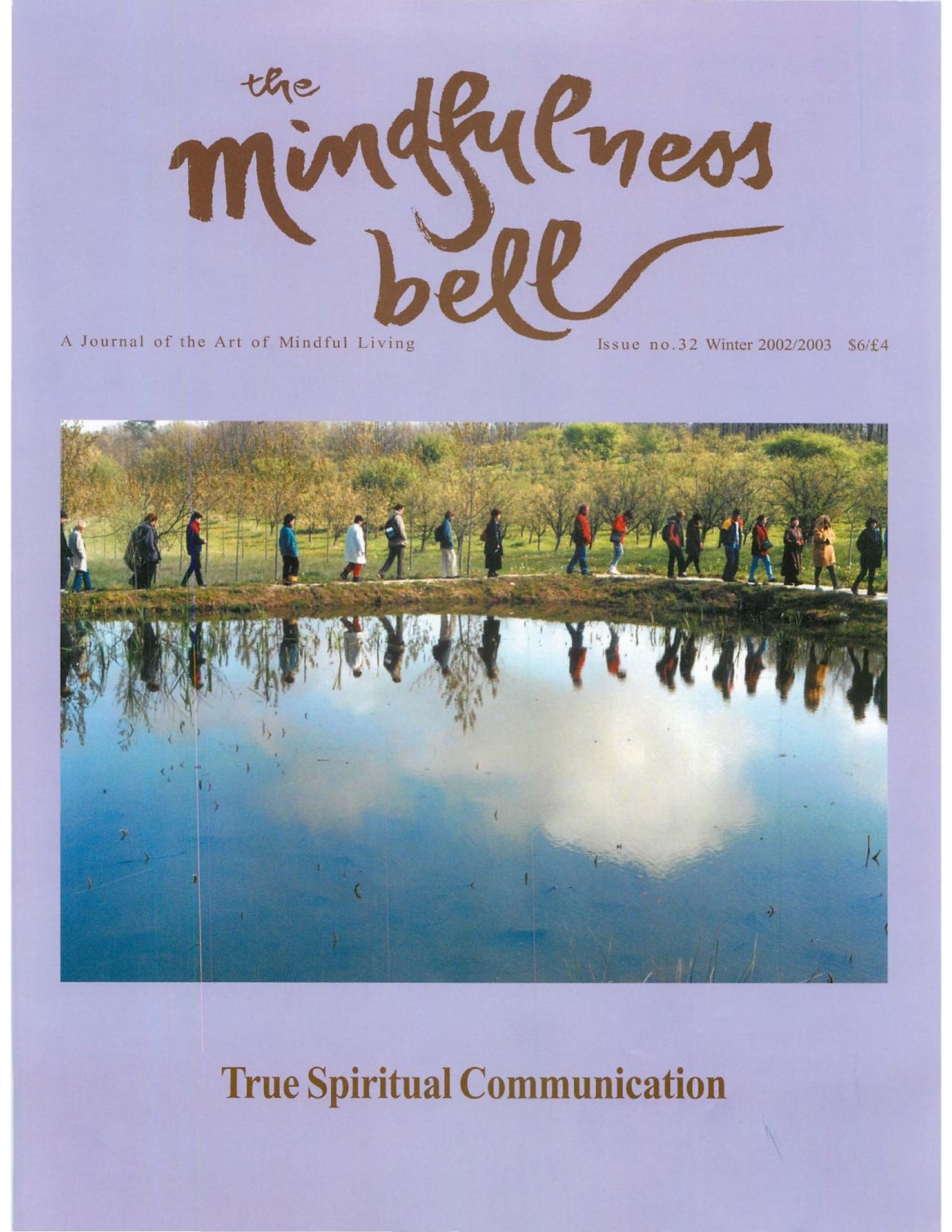Teachings on the Dimension of Action of Avalokitesvara, the Bodhisattva of Great Compassion from the Universal Door Chapter of the Lotus Sutra
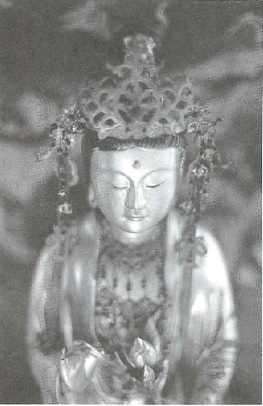
When the bodhisattva named Inexhaustible Mind heard the name Avalokitesvara, he asked the Buddha, “Why did that bodhisattva get such a beautiful name?” The Buddha replied, “Because the actions of Avalokitesvara can respond to the needs of any being in any circumstance.” Then Bodhisattva Inexhaustible Mind asked,
Teachings on the Dimension of Action of Avalokitesvara, the Bodhisattva of Great Compassion from the Universal Door Chapter of the Lotus Sutra

When the bodhisattva named Inexhaustible Mind heard the name Avalokitesvara, he asked the Buddha, "Why did that bodhisattva get such a beautiful name?" The Buddha replied, "Because the actions of Avalokitesvara can respond to the needs of any being in any circumstance." Then Bodhisattva Inexhaustible Mind asked, "How does this bodhisattva enjoy being on this Earth? How does he enjoy walking and contemplating and going about this planet?" The word used in this question is a verb that means you relax and enjoy yourself. Answering that question, the Buddha talked about the way Avalokitesvara spends his or her time on this planet.
We all have time to spend on this planet and the question is whether we enjoy it or not. What are we doing? Do we really enjoy our time sojourning on this planet? Do we carry a lot of luggage, making it feel too heavy to enjoy our time here?
Avalokitesvara is a manifestation and any manifestation has to be situated in time and space in the historical dimension. The Buddha Shakyamuni manifested himself as a prince, as a practitioner, as a monk, and as a teacher. His manifestation lasted eighty years. We are also manifestations. We manifest ourselves in the historical dimension and there are things we want to do and we want to enjoy what we do.
The Interbeing of the Historical and the Ultimate Dimensions
Everything has its historical dimension as well as its ultimate dimension. In the ultimate dimension we are in touch with the essence, the substance, the ground of a person or a thing. In the historical dimension we get in touch with the appearance or the form of something or someone. If we speak about a bell, the substance that makes up the bell is metal. The form of the bell is a manifestation from that ground. So in the historical dimension you can see the ultimate dimension. We also carry with us our ground of being. It's like a wave that manifests herself on the surface of the ocean. The wave is also the water and touching the historical dimension of the wave deeply, you touch the water, her ultimate dimension.
Yesterday there was a question about God. Our friend asked, "I thought that there is no God in Buddhism. Why is Thay speaking about the Kingdom of God?" It's true that in Buddhism we do not talk about God but we do talk about nirvana, the ultimate dimension. If God means the ultimate dimension, the foundation of all manifestations, then there is God in Buddhism. Our ground of being is the nature of no birth and no death, no coming and no going. We call that "nirvana", the ultimate. If you understand God to be the ultimate, to be the foundation of every manifestation, then we can speak about God. If by God we mean an old man with a beard sitting in the clouds and deciding everything for us, we don't talk about that God.
The Dimension of Action
What is the purpose of a bell? How does the bell serve? The bell offers sound for us to practice. That is the function of the bell. This is called the dimension of action. We all have this third dimension. Although we carry within ourselves our true nature we also enjoy manifesting ourselves through our jobs and activities. The Buddha Shakyamuni wanted to do something, that is why he manifested himself. The bell wants to do something, that is why she has manifested herself as a bell. There is something we want to do, in our current manifestation. The dimension of action is connected to the dimension of history, and the dimension of history is very much linked to the dimension of the ultimate.
Our body in the historical dimension may have a beginning and an end but our body in the ultimate dimension is indestructible. It is our Dharma body. Our body in the historical dimension is the body of retribution. The form and manifestation of our physical body is a result or retribution of the lives of our ancestors and our own way of living and being in the world. While using this body of retribution we can practice touching our Dharma body. Everyone has a Dharma body and if you can touch your Dharma body you are no longer afraid of birth and death. The moment the wave realizes that she is water, she is no longer afraid of being and nonbeing, birth and death. As water she doesn't mind going up and going down. She can ride freely on the waves of history without fear. The role of the bodhisattva in the dimension of action is to help people to touch deeply their ultimate dimension because once you have touched your ultimate dimension you lose all fear of birth and death. You realize that this manifestation is just a continuation. Before this manifestation you were already there in your ancestors and after this manifestation disintegrates you will continue in your descendants and in all forms of life.
The Universal Door
The twenty-fifth chapter of the Lotus Sutra is called "The Universal Door Chapter." This chapter is about the dimension of action of the bodhisattva Avalokitesvara. The Universal Door refers to the kind of practice that can respond to all situations of suffering in every place and in every time. This chapter is about love, and Avalokitesvara is the bodhisattva of love and compassion.
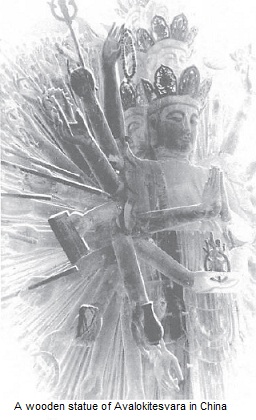
Avalokitesvara is translated as Quan Tu Tai or Quan The Am in Vietnamese. Quan means to observe, to look deeply or to recognize. In Sanskrit this word is the same as vipasyana, to look deeply. Vipasyana goes together with samatha, or stopping and concentrating. You select a subject, you stop and concentrate on that subject and you look deeply into it. It may be your anger, your despair or a difficult situation you find yourself in. Tu Tai means freedom. Thanks to looking deeply you get the freedom you need. In the Heart Sutra the bodhisattva Avalokitesvara found out that everything is empty of a separate existence. Upon having that realization he became free from all afflictions. The Am means the sounds of the world. Quan The Am is the one who looks deeply into the sounds of the world.
Living beings express themselves in different ways. Whether they express themselves well or not, the bodhisattva Avalokitesvara can always understand them. If a child doesn't have enough words to express herself the bodhisattva is still able to understand the child. If the person expresses himself in spoken language or in bodily expression the bodhisattva also understands.
Avalokitesvara has the power of manifesting herself in so many forms, and she is capable of being present everywhere at the same time. When you go to a temple, whether it is in Vietnam or Tibet or China you might have a chance to see a statue of a bodhisattva with 1,000 arms. Each arm holds an instrument. One of her hands is holding a book; it may be a sutra or a book on political science. Another hand is holding a bell. Another hand is holding a flute or a guitar. And a bodhisattva of our time may hold in one hand a computer. In the Plum Village Chanting and Recitation Book there is an English translation of the verses of this chapter made by Sister True Virtue. In this translation the bodhisattva is called a she. And in Asia many people think of Avalokitesvara as a she. But in fact the person can be a he as is explained in the sutra. The bodhisattva can manifest herself as an artist, a politician, a musician, a Dharma teacher, a gardener, a little boy, a little girl, even as a millionaire or the head of a big corporation. If the situation needs his or her presence she will be there in the appropriate form to respond to the situation. Compassion can take so many forms.
Cultivating Compassion
"Whoever calls her name or sees her image, if their mind is perfectly collected and pure, they will then be able to overcome the suffering of all the worlds. When those with cruel intent push us into a pit of fire, invoking the strength of Avalokita, the fire becomes a refreshing lake.” 1
Calling the name of Avalokitesvara may give rise to something in your mind. Your mind becomes concentrated, mindful, calm, and lucid. If you call her name in such a way that your mind becomes still then you will be able to overcome your suffering. Evoking the name of Avalokitesvara is one of the ways to allow understanding and compassion to be born in our hearts. When something or someone can offer you freshness, joy, and loving kindness, the image of that person becomes the object of your contemplation. Every time you think of her or of him, suddenly the elements of compassion and understanding are born in your heart and you can overcome the suffering you are experiencing at that moment.
A place can also embody compassion and understanding. Suppose you come to Plum Village and you enjoy the beauty of the nature and the lifestyle. When you leave, every time you think of Plum Village you have a pleasant feeling. That is the meaning of mindfulness or contemplation. The object of mindfulness is the image or the sound that can inspire us and can produce the element of understanding and compassion in us. It is not just devotion. We should not invoke the name of Avalokitesvara or visualize the form like a machine; doing that will not provoke any calmness or mindfulness. To evoke the energy of Avalokitesvara is the practice of calming and concentrating our mind to bring back the nectar of compassion and understanding in us. That practice can help us avoid all kinds of dangers.
Avalokitesvara can also manifest himself in many names. The message of Jesus is love. Jesus said, "I am the Way." Avalokitesvara may say, "I am the Universal Door." We all have our Avalokitesvara, of different names and forms. What is essential is that that name can help us to calm down and to make understanding and compassion possible.
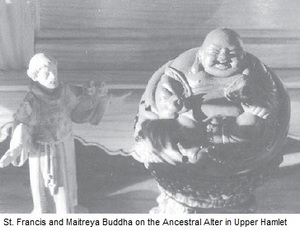
"When those with cruel intent push us into a pit of fire, invoking the strength of Avalokita, the fire becomes a refreshing lake." How can we understand this statement? If you are pushed into a pit of fire and you know how to be mindful and to recollect the powerful energy of Avalokitesvara then the pit will be transformed into a cool lake. The cool lake is inside and it is also outside.
In the same chapter of the Lotus Sutra we read, "If there is a person who is a victim of ignorance and that person knows how to be mindful of the great compassion of Avalokitesvara then he will free himself from ignorance. If a person is a victim of anger and she knows how to practice mindfulness of the great energy of Avalokitesvara then she will be free from her anger." We have to understand all of these verses in that spirit.
Sometimes a whole nation is plunged into a pit of fire made of anger. Imagine how big that pit of fire must be. If you know how to be mindful of compassion, and of Avalokitesvara who is the symbol of compassion and understanding, then you will calm yourself down. You will be able to see more clearly and your anger will subside. After September 11th, I recommended that America engage herself in the practice of stopping, calming and looking deeply to see what to do and what not to do to respond to the situation with compassion and lucidity. This is the action of Avalokitesvara.
Drawing Dangers into Ourselves
In the Universal Door Chapter we read about many dangerous situations such as: caught in a fire, caught in a flood, caught in a war, caught in a situation where we suffer so much. Usually we believe that dangers come from the outside. We do not realize that most of the dangers we are afraid of come from within us and not from some objective situation. When you do not have a clear view, a right understanding of reality, you create a lot of fear, misunderstanding, and danger. When you have the element of anger, delusion, and craving within yourself, you draw danger into yourself. You create your own suffering. The practice of compassion, the practice of deep looking helps you to be lucid, to be loving, and that lucidity and that loving kindness is a protection from all kinds of dangers.
It is clearly stated in the sutra that if you are caught in a situation of anger and you know how to produce mindfulness of love then you will be free from that situation. If you are caught in the situation of delusion and you know how to practice mindfulness of compassion then you can get out of that situation. That is the Universal Door.
The Fierce Bodhisattva and the Gentle Bodhisattva
Is it possible to carry a gun and yet remain deeply a bodhisattva? This is possible. When you enter the gate of a temple, you see the statue of a very gentle bodhisattva on your left, smiling and welcoming. But looking on your right you see a figure with a very fierce face, holding a weapon. His whole face is burning. Smoke and fire are pouring out of his eyes and his mouth. He is the one who has the capacity to keep the hungry ghosts in order. Every time we organize a ceremony to offer food and drink to the hungry ghosts, to the wandering souls, we need to evoke the bodhisattva with the burning face (Dien Nhien Vuong) to come and help. The hungry ghosts only listen to him because he has that fierce, "You behave, otherwise you will get it!" look. He is a kind of Chief of Police bodhisattva. That is a manifestation of Avalokitesvara. So when you see someone carrying a gun, you cannot necessarily say that he or she is evil. Society needs some people to carry guns because there are gangsters, there are people who would not behave if there were no one embodying strict discipline. It is possible that someone carrying a gun can be a real bodhisattva because the bodhisattva of the burning face is a real bodhisattva, a manifestation of Avalokitesvara. It is possible for the director of a prison or a prison guard to be a bodhisattva. He may be very firm with the prisoners but deep inside of him there is the heart of a bodhisattva. Our job is to help prison guards and police officers to have a bodhisattva heart.
Today there is a police officer here; she took the Five Mindfulness Trainings in 1991. She knows a lot about the suffering of members of the police force in America. You are supposed to be a peacekeeping force but sometimes you are looked upon as the oppressors, as a symbol of violence. There is violence, there is suppression in society and you have been appointed to keep the peace. It's very hard to do your job if you don't have enough skillful means. If you don't have enough understanding and compassion, a lot of anger, frustration, and despair may grow within you. Then it is possible that you can become the oppressor. The door of your heart is closed. No one understands you; they look upon you as an enemy. There is no communication between you and the world outside that you are supposed to serve. So the suffering of the police may be immense, the suffering of prison guards may be immense. They don't enjoy their job and yet they have to continue. Avalokitesvara must appear in their midst and try to open their hearts. Avalokitesvara says that you can carry a gun, you can be very firm, but at the same time you can be very compassionate.
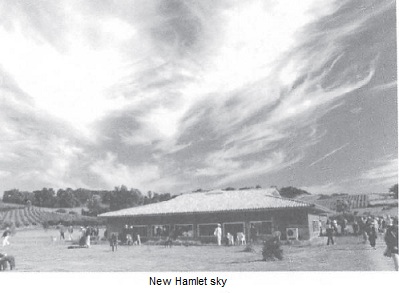
If you play the role of a tender bodhisattva, you have to have real compassion and understanding in you. Usually the First Lady, the wife of the Prime Minister, the wife of the President or the Queen, should play the role of the tender bodhisattva, the figure of a mother, a gentle sister caring for the sick and the poor. While her husband is doing things like conducting the army, conducting war, the First Lady plays the role of a tender bodhisattva. But if she is a real bodhisattva her action will not be just a decoration, she will manifest real compassion and real understanding.
If you have to play the role of the fierce, burning face bodhisattva, even if you carry a weapon and demonstrate your firmness, you have to have a tender heart and deep understanding. If you look for Avalokitesvara only in a nice appearance, you will miss her, because she can manifest herself in all kinds of forms. She can manifest herself in all kinds of bodies: as a child, as an adult, as a judge, as a mother, as a king, as a schoolteacher, as a businessman, as a politician, as a scientist, as a journalist, or as a Dharma teacher. So you have to look deeply in order to recognize Avalokitesvara.
The Eye of Understanding
The ten thousand arms of the bodhisattva are needed because love can express itself in many forms with many kinds of instruments. That is why every arm is holding a different instrument. But if you look closer, you see that in each hand there is an eye. The eye signifies the presence of understanding. Very often by loving someone we make that person suffer because our love is not made with understanding. The other person may be your son, your daughter, or your partner. If you don't understand the suffering, the difficulty, the deep aspiration of that person, it is not possible for you to love him or her. That is why you need an eye for your arm to really be an instrument of compassion. It is important to check whether your loving has enough understanding and compassion in it. You can ask for help. "Darling, do you think I understand you enough? Do I make you suffer because of my love?" A father should be able to ask his son, a mother should be able to ask her daughter that question. "Daughter, do I make you suffer because of my lack of understanding? Please tell me so that I can love you properly." That is the language of love. If you are sincere, your daughter will tell you about her suffering and once you have understood you will stop doing things that you thought would make her happy but really make her suffer. Understanding is the substance with which you can fabricate love.
Transformation Bodies of Avalokitesvara
Several of us are acting like bodhisattvas with several arms. We are taking care of members of our family, and we also participate in the work of protecting the environment and helping the hungry children in the world. We think we have only two arms but many of us are present a little bit everywhere in the world. You can be at the same time here and in a prison. You can be at the same time here and in a far away country where children suffer because of malnutrition. You don't have to be present with this body because you have other transformation bodies a little bit everywhere. And that is why it is very important that you recognize your transformation bodies. When I write a book I want to transform myself into thousands of me in order to go a little bit everywhere. Every book of mine becomes one of my transformation bodies. I can go to a cloister in the form of a book; I can go to a prison in the form of a cassette tape. Each of us has many transformation bodies. That is what the bodhisattva Avalokitesvara does. She can manifest herself in so many bodies. Being a bodhisattva is not something abstract; it's something concrete that you can do.
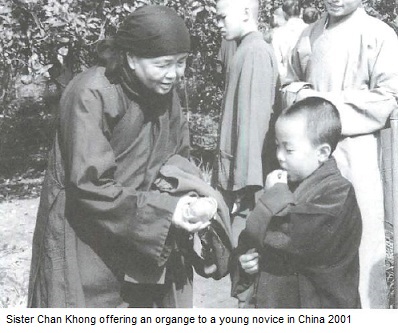
When I was young I read a book written by a French tourist who went to Africa and enjoyed hunting tigers in the jungle. He didn't believe in God. One day, late in the afternoon, he got lost in the jungle. He didn't know how to get out; he began to panic. He wanted to pray for help but because he didn't believe in God he had never prayed before. In his panic, he said, "God, if you really exist, then this is the time to come and rescue me!" There was some arrogance in his way of praying. Right after he said that, there was some noise in the bush and an African gentleman appeared wearing nothing but a loincloth and thanks to that person the Frenchman was saved. Later in his book he wrote an ironic sentence that showed he was not very grateful. He said, "I called for God but only a Negro came." He was not able to recognize God in the person of a native African. He didn't know that the "Negro" who came to him was God, was Avalokitesvara, the bodhisattva of compassion. You have to be very awake in order to recognize the beautiful bodhisattva in an unfamiliar form.
Bodhisattva Avalokitesvara might be very close to you. You may be able to recognize her in the here and now and yet you are looking for him or her in the clouds. Compassion does exist; understanding does exist. It is possible for us to cultivate the energy of compassion and understanding so that the bodhisattva can be with us all the time in our daily life. Then we will be well protected.
Four Skillful Means for Embracing Living Beings
How does the bodhisattva act in order to help living beings to overcome their suffering and to realize their ultimate dimension? We speak of four skillful means used by the bodhisattva, in the dimension of action, to embrace living beings. They are: (1) making offerings, (2) using loving speech, (3) doing things to benefit the other person, and (4) "doing the same thing" or becoming one with the people you want to help.
Offering the Gift of Non-fear
There are three kinds of gifts spoken of in Buddhism: material gifts, the gift of the Dharma, and the gift of non-fear. When you offer things to people, you are practicing compassion and you also open the way for reconciliation and healing. Giving her some beautiful music can help her to relax while listening. Giving him a book on the Dharma may help him to deal with his difficulties. The Buddha said when you are angry with someone and you are capable of giving him or her something, then your anger will die down.
The most precious gift that Avalokitesvara can offer us is the gift of non-fear. People are afraid of losing their identity, of dying, of becoming nothing. When you give the kind of teaching and practice and insight that helps people touch their ultimate dimension, they lose all their fear. But you need to have that gift of non-fear within you in order for you to be able to offer it to others.
Perhaps as a child you have played with a kaleidoscope, a very simple, wonderful toy. I have a few in my hut. In it there are loose bits of colored materials and two mirrors at one end that show many different patterns. Each pattern is a beautiful manifestation. If you turn it a little bit, that manifestation will be replaced with another manifestation. Every manifestation is beautiful. As a child, you don't regret when one manifestation replaces another. The manifestations also, no matter how beautiful they are, do not feel sorrowful when they give their place to the next manifestation. The child just enjoys the changes without any regret because the next manifestation is as beautiful as the current one. There is no fear, no regret because all manifestations have the same ground, the little bits of colors in the kaleidoscope. The ground of all manifestations is always there. If you can touch the ground, you don't mind the changes. You are not caught by this body, you know this is just one manifestation. You are ready to manifest in another form as wonderful as this one.
The Loving Speech of a Bodhisattva
The second skillful means is to use loving speech. You can be very firm and uncompromising, and still use loving speech. Loving speech can convey your feeling and your idea to the other person better than shouting at them, blaming them, or being sarcastic and sour. A bodhisattva should be able to use loving speech.
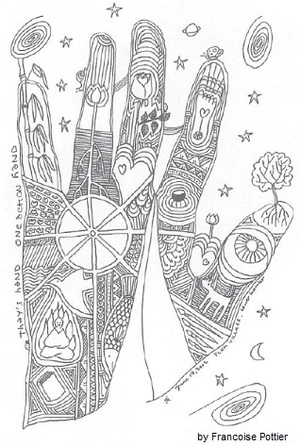
I would like to return to the example of the police bodhisattva. Seeing the way people react to the police, the police officers' hearts harden every day. They feel very isolated; they feel they are victims of society. So the police bodhisattva can propose that the community of police officers organize an open house. They will prepare food and beverages and will invite the neighborhood to come and hear the story of the life of a police officer. You can tell them, "When I set out in the morning carrying my gun and going to the street, my spouse does not know whether I will come home safely because there is so much violence in society. Although we carry guns we can be killed or maimed by other people. So we start our day with fear, with uncertainty; we don't know what will happen to us during that day. Our task is to impose order, but maybe we will be victims of violence on the street. If we do our job with anger and fear in us, we cannot do it well. That is why we suffer as police officers. We really want to help but we suffer very much. When we go home we cannot offer joy and compassion to the people in our home because it was so hard during the day. If there is no happiness in our home, we are not nourished."
Then members of the community will have more understanding and compassion for you. Communication is possible. There can be collaboration between the police officers and community members. There must be a way out of even the most difficult situations. The way out is through listening with compassion and using loving speech. Once communication is restored we have hope and suffering will be lessened.
The third skillful means is to do things that benefit the other person. From your actions the other person feels safer and has more opportunities for a happy life. Showing people how to receive training to obtain a job, how to increase their family 's income, how to improve their health or have more security, are examples of the kinds of action that benefit people.
The Skillful Means of "Doing the Same Thing"
The fourth skillful means is, you become one of them. You look like them, you wear clothes like them, and you do exactly what they are doing, in order for them to have a chance to learn the path of understanding and love. That is the action of the bodhisattva.
Nowadays there are so many youngsters who belong to gangs. Each gang may have thirty or forty members, each with a leader. In order to help transform their hearts and minds, you have to transform yourself into a gang leader. You look like a delinquent but you are really a bodhisattva because that is the only way to approach them. You have to talk like them, you have to behave and wear clothes like them in order to be recognized and accepted, then you can begin to help transform their hearts. That is called the practice of "doing the same thing." That is what Bodhisattva Avalokitesvara can do. So in the prisons you can manifest yourself as a fellow prisoner and you become the bodhisattva among prisoners. In the police force, you have to manifest yourself as a police officer, and you play the role of bodhisattva in order to bring about relief, understanding, and compassion.
A Bodhisattva in Prison
There is a nun who is a student of mine who has spent a lot of time in prison. When she was young she had the opportunity to study English literature in a university in America. She ordained as a nun in Vietnam. She was imprisoned because she participated in activities to promote human rights. During the time she was in prison she practiced walking meditation and sitting meditation every day, although her cell was very small. Thanks to the practice she remained calm and fresh; anger and despair were not able to seize her. She was able to help the other prisoners. Other prisoners had a lot of anger that showed on their faces when they interacted with the prison guards. But she was treated well by the prison guards, not because she was a nun, but because she had the compassionate look of a practitioner. She was smiling and fresh that is why they didn't worry about her.
The fact is that while being in prison she was not a victim of anger and despair. She was able to make use of her time there, like a retreat. She didn't have to do anything ,just enjoy the practice. She grew up spiritually during her time in prison. Instead of transforming her prison cell into a pit of glowing embers, she transformed her dwelling into a cool lotus pond because she knew the practice of mindfulness, compassion, and understanding. If we find ourselves in a situation like hers and we know how to practice the Universal Door of mindfulness and compassion, then we will not suffer and we can help people who are in the same situation. We can also help people like the administrators and prison guards.
Praising Avalokitesvara
"From the depths of understanding, the flower of great eloquence blooms: the Bodhisattva stands majestically upon the waves of birth and death, free from all afflictions. Her great compassion eliminates all sickness, even that once thought of as incurable. Her wondrous light sweeps away all obstacles and dangers. The willow branch in her hand, once waved, reveals countless Buddha lands. Her lotus flower blossoms a multitude of practice centers. I bow to her, to see her true presence in the here and now. I offer her the incense of my heart. May the Bodhisattva of deep listening embrace us all with great compassion. Homage to Bodhisattva Avalokitesvara." -- Verses of Praise from the Plum Village Chanting and Recitation Book.
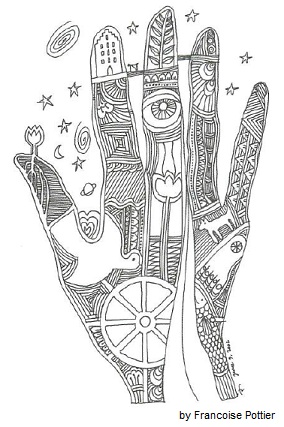
In this chant praising Avalokitesvara you begin to see that the bodhisattva Avalokitesvara has a deep understanding of your situation, of the situation of the world. And she is able to convince you with her great eloquence to follow the path of understanding and love. She is free from the dust of craving, anger, and delusion. Her nectar of compassion can heal all kinds of sickness whether it is depression or cancer. The best kind of medicine is compassion. Without compassion it is very difficult to heal. You need compassion from the inside and from the outside. The light emitted by him or her sweeps away all kinds of dangers. You draw dangers into yourself by your craving, hatred, and delusion. But because you have the light of compassion, you can dissipate and be free from all of these dangers.
The bodhisattva holds a willow branch in her hand. When she waves it she reveals countless Buddha lands. The Buddha land is right here, right now, but because we are deluded and caught in our anger we don't see the wonders of life, the wonders of the Pure Land in the present moment. We need her to use a willow branch in order to reveal it to us. She dips the willow branch into the nectar of compassion and as she spreads it, she transforms suffering into joy. With the nectar of compassion you can do everything. You can transform death into life, despair into hope. It is possible for you to cultivate the nectar of compassion like a bodhisattva. With her pink lotus flower she creates a multitude of practice centers. There are many practice centers in Germany, in England, in America, and in Israel. You are an arm of the bodhisattva; you are establishing Mindfulness Practice Centers everywhere. I bow my head; I praise her, I praise compassion, and I offer the incense of my heart. Please manifest yourself in the here and the now for us.
The Ten Virtues of Avalokitesvara: The Five Contemplations and the Five Sounds
"Look of truth, look of purity, look of boundless understanding, look of love, look of compassion, the look to be always honored and practiced."
If you want to know the nature and the practice of Avalokitesvara, you should be aware that she practices five kinds of contemplations: of truth, purity, great wisdom, compassion, and loving kindness. The first contemplation comes from the definition of her name, Quan, meaning looking deeply into the truth of reality. You have the capacity to distinguish the true from the false, the beautiful from the ugly.
The second contemplation is the contemplation on purification. Like a cloud in the sky, she has to purify herself so that when she becomes the rain, the rain will be pure for the sake of the world. To be a cloud floating in the sky is wonderful, but it is also wonderful to be the rain falling on the mountains and the rivers. To become the snow on the top of a mountain is also wonderful. To be a drink in a glass of water for a child is also wonderful. So water can manifest herself in many forms and every form is wonderful. That is why bodhisattvas are not caught in one form of manifestation, in one body. We know that this manifestation is linked to the next manifestation in terms of cause and effect.
If the cloud is polluted then the rain will be polluted also. That is why, while being a cloud you purify yourself so that when you become the rain you become very pure, delicious water. You know that there are many clouds that carry within themselves a lot of dust, a lot of acid. The clouds that hang over big cities are quite polluted. When they become snow the snow is not clean; when it becomes rain, it can carry a lot of acid and destroy the forests. So while you are a cloud try to practice self-purification so that when you are transformed into snow and water you will be more beautiful. By self-purification, you help with the purification of the world.
We know we draw dangers to ourselves because of the way we look at things and because we have craving, anger, and delusion in us. That is why self-purification, learning to look deeply to remove our anger, our craving, and our delusion is to remove danger. Especially when you touch the ultimate, you are no longer afraid of anything.
The third contemplation is the contemplation on the great wisdom, maha prajna paramita. The object of your contemplation is not just knowledge, but the great wisdom that has the power of bringing you to the other shore, the shore of safety, the shore of non-fear, the shore of well-being.
The fourth contemplation is the contemplation on compassion, the energy with which we can embrace all beings whether they are sweet and lovable or unkind and cruel. The fifth contemplation is the contemplation on loving kindness, the energy that is the opposite of what we feel towards an enemy. When we contemplate on loving kindness we feel our association and friendship towards all beings. We should practice contemplation of these five objects.
The Five Sounds of a Bodhisattva
"Sound of wonder, noble sound, sound of one looking deeply into the world, extraordinary sound, sound of the rising tide, the sound to which we will always listen."
This verse in the Universal Door Chapter speaks about five kinds of sounds that characterize the bodhisattva Avalokitesvara. The five sounds are the sound of wonder, the sound of he or she who understands the world, the noble sound, the sound that is powerful like the sound of the rising tide, and the sound that surpasses all sounds in the Locadhatu, the mundane world.
First is the sound of wonder: you yourself are a wonder, the tree in the front yard is a wonder, the Earth is a wonder, the sun is a wonder, and the galaxy is a wonder. You should listen in such a way that you can hear the sound of the wonders. Otherwise you are living in a dream. You are in the kingdom of wonders and yet you are not in touch. That is why you have to listen. You listen to the mountain, you listen to the flower, you listen to the birds, you listen to yourself, and you become aware that everything is a wonder.
The second sound is the sound of he or she who practices looking deeply into the world. The Buddha is described as "he who deeply understands the world." All of us who are friends, disciples, continuations of the Buddha, do the same. We try to look deeply into the world in order to understand better. That is the meaning of meditation. To meditate is to have the time to look deeply at what is there. And looking like that we come to understand the world, to understand ourselves, and we are free from afflictions, from making mistakes.
The third sound is the sound of nobility. There are sounds that are heavy, that carry a lot of craving, a lot of despair. But when you are a practitioner you are on a path of self-purification and the sound you emit every day becomes finer and finer, because every cell in your body, every mental formation in you is on the way to self-purification and transformation. That is why the sound emitted by our cells becomes more and more noble. That is what happens with the bodhisattva; her sound is a wonderful sound, that is high and noble. If you are mindful and concentrated, you can tune in to that sound for your pleasure, for your transformation, and for your healing.
The fourth kind of sound is the sound of the rising tide. When I was a student at the Buddhist Institute I invited other students to produce a newsletter for the students of the seminary and I proposed the title, "The Voice of the Rising Tide." But because we wrote so many radical thoughts, later on we were forbidden to continue with our publication. The sound of the rising tide is very powerful. If you can tune in to that sound, you receive transformation and healing. That sound can embrace and take away the sounds that are vulgar, that are low. The fifth kind of sound is the sound that can transcend all the other sounds of the world. The Locadhatu emits the sound of the world, while the sound emitted by the bodhisattva reveals to us the Dharmadhatu, the realm of ultimate reality, the Pure Land.
When you practice being aware of Avalokitesvara, you get in touch with these five kinds of sounds and these five kinds of contemplations. This is the essence of Avalokitesvara. Avalokitesvara is not the name of a god. Avalokitesvara is a real person having real qualities characterized by these five contemplations and five sounds.
Compassion Like Thunder
"Strength of Thunder, Calmness of Clouds Heart of compassion like rolling thunder, heart of love like gentle clouds, water of Dharma nectar raining upon us, extinguishing the fire of afflictions."
The element of karuna, of compassion, is like thunder. Compassion is not something soft, it is very powerful, like thunder. The element of maitri, of loving kindness, is like a wonderful great cloud causing the rain of the Dharma to fall down like nectar, extinguishing all the fire of afflictions. You have two images, the thunder and the cloud. When these two things come together, it produces the compassionate Dharma rain falling down, extinguishing all kinds of afflictions.
Taking Refuge in Holiness
"Contemplation on Holiness: With mindfulness, free from doubts, in moments of danger and affliction, our faith in the purity of Avalokita is where we go for refuge."
In every moment, dwelling in mindfulness without any doubt, we have great confidence in the power of compassion and understanding. Avalokitesvara becomes the object of our mindfulness, of our recollection. Even in danger or dying, you maintain that kind of awareness because Avalokitesvara is a holy entity, a saint. Wherever there are the elements of mindfulness, concentration, and insight, there is the element of holiness. Avalokitesvara is a holy person and if we make him or her into the object of our mindfulness, we get the element of holiness in us. That is why we don't have to be afraid of dangers anymore, even prison or death. She is the element of holiness and she is our refuge and our protection. That is the next to the last verse.
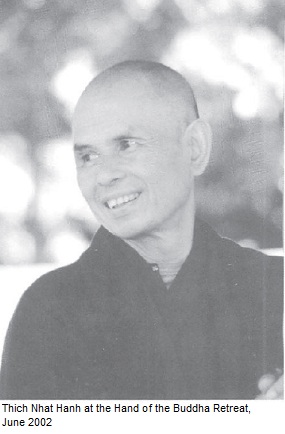
Looking at All Beings with the Eyes of Compassion
"We bow in gratitude to the one who has all the virtues, regarding the world with compassionate eyes, an Ocean of Well-Being beyond measure."
The last verse says, fully equipped with all kinds of merits, she is capable of looking at living beings with compassionate eyes. I think this is the most beautiful sentence in the whole Lotus Suta. Use the eyes of compassion to look at living beings. When you understand the suffering of the other person, you can accept him or her and suddenly compassion flows out of your eyes and you will help that person to suffer less. Using compassionate eyes to look at living beings is the most beautiful practice. You have a compassionate eye; the Buddha eye has been transmitted to you. The question is whether you want to make use of that eye.
The merits are accumulating into an infinite ocean. Merits can also be translated as happiness or well-being. You cannot describe the great ocean of happiness. Happiness is made of one substance, called compassion. That is why in cultivating compassion you cultivate happiness for yourself and for the world. Happiness is described not in terms of pounds or kilograms but in terms of oceans. Our happiness accumulates and becomes an infinite ocean. We touch the feet of the bodhisattva with our forehead to express our deep gratitude and respect.
On the Gridakuta Mountain where the Buddha delivered the Lotus Sutra, Shakyumani was playing the main role, the role of the Buddha, and Avalokitesvara played the role of a bodhisattva. But in many sutras we have learned that Avalokitesvara became a Buddha a long time before and is a fully enlightened person. Yet coming to the Gridakuta Mountain, he played the role of a disciple of the Buddha. This is a kind of play because if there is a teacher, there must be students. If there are students, there must be a teacher. So you take turns in order to be a teacher or a student. Some time later you will become a teacher and I will be your student. This is the tenth door of the Avatamsaka Sutra. It's like a formation of wild geese in the sky. If the leader gets tired, he slows down and lets another lead. Sometimes you play the role of the leader, sometimes you play the role of a follower and you don't discriminate at all, you are equally happy. With that we can conclude the Universal Door chapter and we know that Avalokitesvara has played the role of the student very well. But if we look deeply into her personality, her action, her wisdom, we know that no one can surpass her in terms of compassion and understanding.
From Dharma talks by Thich Nhat Hanh on June 9th, June 14th, and June 15th, 2002 during the twenty-one day Hand of the Buddha Retreat in Plum Village, France. Transcribed and edited by Barbara Casey and Sister Steadiness.
1 "Discourse on the Lotus of the Wonderful Dharma: Universal Door Chapter" found in Plum Village Chanting and Recitation Book (Berkeley: Parallax Press, 2000). All following quotes in this article are from the same source unless noted otherwise.
To request permission to reprint this article, either online or in print, contact the Mindfulness Bell at editor@mindfulnessbell.org.


